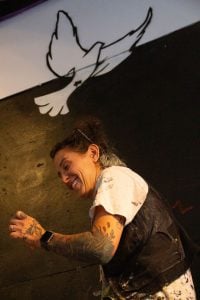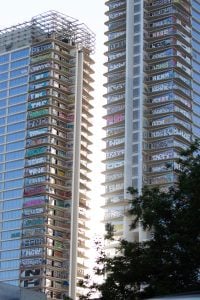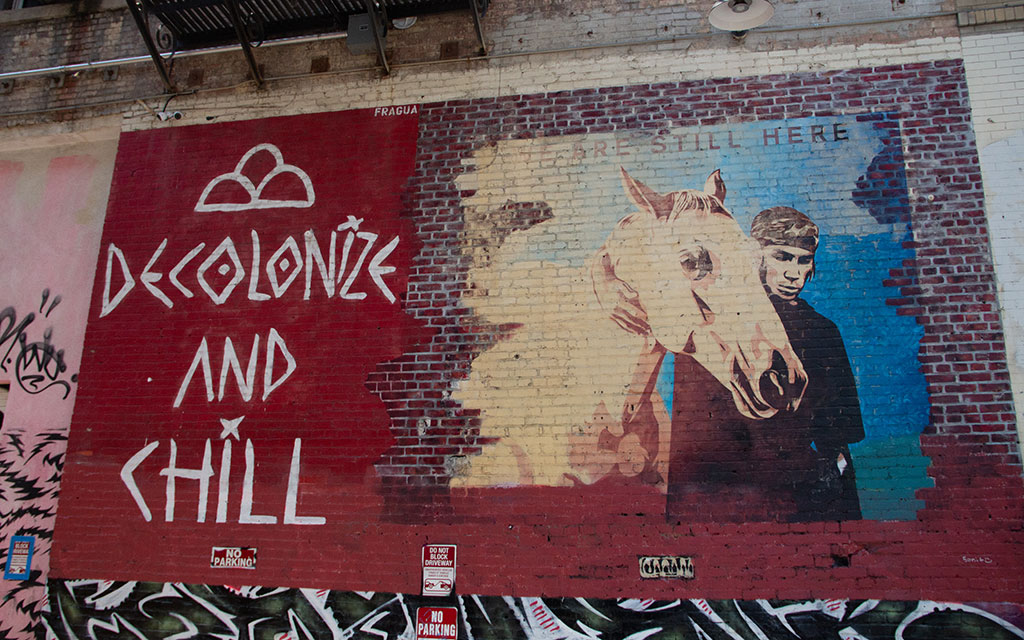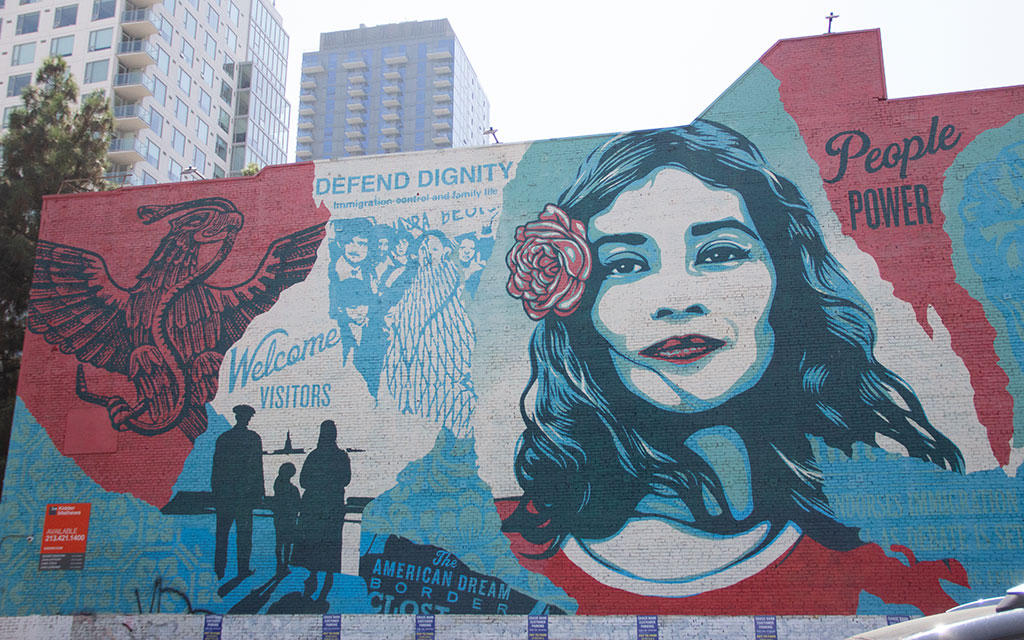LOS ANGELES – In the heart of Los Angeles, art is more than a form of expression. Be it a blank brick wall or a stage under spotlights, artists here use every platform as a vehicle to amplify social discourse.
Corie Mattie, aka “LA Hope Dealer,” an LGBTQ+ artist, is turning the street into her canvas, calling out local and national injustices. She is challenging social norms one bold stroke at a time.
“I had to really take the things that speak to me. Being a woman, being gay and then there’s things that just aren’t fair,” Mattie said. “I have to speak out against it even if it doesn’t affect me. It’s just one of those things where I have to call attention to it.”
LA Hope Dealer raises awareness of queer rights, gun control and social justice cases like that of George Floyd, a Black man who was a victim of police brutality. Mattie’s work includes large murals and sculptures that combine recognizable pop culture with activism.
The City of Angels has long been a cultural haven for aspiring creatives beyond film and entertainment. The street art on highway entrances or alley roads reflects the city’s rich history.
From paid murals to graffiti tagging, street art reflects its history, diverse population and the complex issues within often underserved communities.

Corie Mattie often tackles serious subjects through her art creation, including gun violence, human rights and current events. Photo taken Sept. 4, 2024, in her Skid Row studio. (Photo by Emery Davis/Cronkite News)
Renowned artist like Shepard Fairey, aka Obey Giant, has made his mark across LA, but the local artists are the unsung heroes of the neighborhood as they reflect and engage the community’s voice.
LA continues to grapple with one of the most extreme homelessness crises in the nation alongside growing housing affordability concerns.
In the middle of downtown stands Skid Row, which is home to many low-income, displaced and unhoused individuals amid neighboring upscale high-rise apartments, reflecting the stark divide between poverty and wealth known throughout LA.
Alongside community organizations working to create opportunities for local Angelenos, different kinds of artists are making their way. Armed with a can of spray paint and a message, they take to the walls of one of the most populated cities in America.
Mattie explained her approach to art activism by emphasizing humor and sarcasm when addressing heavy topics. Her process involves reflecting on newsworthy issues and working backward to develop ideas.
During the COVID-19 pandemic, she used the Centers for Disease Control and Prevention guidelines as inspiration. “For me, in the pandemic, every day it was, the CDC recommends this,” Mattie said of her pandemic murals that highlighted pop culture references. “It was pairing something serious to something social … so it’s always something that I try to find in the news, but then mix it with something that people can resonate with.”
For what would have been Betty White’s 100th birthday, Mattie painted a mural and used her image. White, during her life, was outspoken in her support and donations to animal rescues. The painting on the famous Melrose Avenue garnered significant attention, including a $20,000 donation to Wagmor Pets, an animal rescue organization. Mattie added a QR code allowing donations directly to the nonprofit.
Art Share L.A.: Providing housing and opportunities
Art Share L.A. goes beyond just occupying space for creativity – it offers inclusive opportunities and housing for those who need it most and is working to change the narrative of a “starving artist.”
The promise of developing opportunities and eliminating complex systems of power and privilege in the creative economy is written in its mission.

Street artist Corie Mattie uses imagery of doves to express freedom of expression and defiance against societal norms in her art. Photo taken Sept. 4, 2024, in her Skid Row studio. (Photo by Emery Davis/Cronkite News)
“Our mission is to uplift emerging and underrepresented artists by giving them the space to live, work, perform and exhibit,” said Ree Magaña, marketing and communications manager. Established in 1998, ArtShare LA provides 30 affordable housing units and studio space for emerging and underrepresented artists.
Magaña’s association with Art Share L.A. goes beyond being an exhibit artist and staff member. Remembering their journey, Magaña shared how the program has shaped their life.
“I actually lived here for almost two years, and almost half of our staff does live upstairs. We are all artists ourselves so the passion that we have for this work is very personal and dear to all of our hearts. Living here really did save me.”
“I was at the time, like 19, and was couch surfing, and was at a point where I needed a space, where it wasn’t only just home for myself … but as an artist and as a creative,” Magaña continued. “Being in a space where my creativity and my outlook on life was not just appreciated but celebrated.”
The organization in downtown LA has faced challenges due to gentrification and high rents but continues to advocate for marginalized voices through programs like an artist residency and a professional skills series.
History of displacement in LA
Los Angeles County has experienced some of the highest rates of gentrification in the country over the last 20 years, according to the Urban Displacement Project. Disadvantaged neighborhoods are rapidly shifting to wealthier areas, with new businesses and more affluent residents.
During the 1960s, urban renewal projects in downtown LA initiated redevelopment in the area. City administrators began enforcing stricter fire safety codes, targeting many rundown residential hotels. Building owners were given a choice: to either restore their buildings at their own expense or demolish them. Due to high costs, many chose demolition, which cut housing in the area by half and displaced residents, according to the Los Angeles Area Chamber of Commerce.

Abandoned structures found near 11th and Figueroa streets are covered in graffiti and showcase the colorful culture of Los Angeles street art. Photo taken Aug. 28, 2024, in downtown Los Angeles. (Photo by Emery Davis/Cronkite News)
In the mid-1970s, the Central Business District Redevelopment Project aimed to revitalize the downtown area by reviving the remaining housing and adding clinics, parks and shelters. However, this led other communities to send their homeless populations to Skid Row in downtown LA instead of addressing the issues locally.
Baha Danesh, visual arts manager and curator of Art Share L.A., has lived in the city since 2007 and has seen the art scene and city evolve together.
“We started to get more artists who were able to show in more places because there were more opportunities for them. However, that was downplayed because there were artists who had been living downtown for years, and they started to get displaced. There was a good and bad thing happening. Yes, there were more opportunities to show, but there were artists who were getting priced out of living downtown,” Danesh said.
Performance art in Skid Row
The Los Angeles Poverty Department has earned recognition as one of the first art initiatives dedicated to serving the Skid Row community. Through its carefully choreographed performances and various art projects, social justice issues are given the spotlight.
In 1985, artistic director John Malpede founded the organization in response to the growing displacement problem in Skid Row. It touts itself as the first performance group in the country made up primarily of unhoused individuals.
The troop has built a reputation as a defender of the community. Members spotlight issues that affect not only the downtown community but also the broader California area.
A 2009 performance created an immersive experience to address prison overcrowding. The seats in the performance room were removed and replaced with prison beds, symbolizing the overcrowding. The audience was invited to sit on the beds and the performance unfolded around them within the tight space.
Performances have taken the group to Cleveland, Detroit, New York and Bolivia, which has brought California’s social discourse to a global stage.

Street artist Corie Mattie uses imagery of doves to express freedom of expression and defiance against societal norms in her art. Photo taken Sept. 4, 2024, in her Skid Row studio. (Photo by Emery Davis/Cronkite News)
The 2013 performance titled “Biggest Recovery Community Anywhere” not only challenged the negative narrative of Skid Row but celebrated the community’s accomplishments. It was performed in LA and Honolulu.
“You always hear the dominant narrative is that it’s (Skid Row) not a neighborhood. It’s full of transients, it’s full of drugs and stuff like that,” Malpede said. “But there are 50 recovery meetings every week, led by people in the community. We pointed that out, which made a big impact.”
Malpede emphasized the significance of preserving the heart and soul of LA.
“There’s always incentive for people who are interested in making good bazillions of dollars to force out the community and in order to make money. … Those people aren’t stopping,” Malpede said of gentrification efforts. “It’s important to keep engaging the community and keep pointing out the assets. It (Skid Row) only exists because of activism and community building.”




